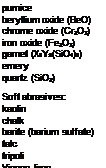Look at this small grit, this tiny grain, so small one must rub hundreds of them between finger and thumb to feel their sharpness. Insignificant little grits and easily slighted in our sophisticated technological world, but without this small fragment of abrasive, transformed, when viewed under a microscope, into jagged heroic blocks — without these small grits ours might still largely be an agricultural society and the conquest of space merely a dream. With these grits are grinding wheels made. [LEWI76, p. 3]
The main task of the abrasive grits is to conduct material removal that arises from chip formation, surface shattering, or pressure softening. In most applications, the grits have to be harder than the machined workpiece material. Moreover, abrasive grits need a high toughness and thermal and chemical resistance for a sustainable tool life. In addition, appropriate fracture behavior of the grits enables tool self-sharpening and results in efficient machining processes. A wide variety of abrasive materials is used in abrasive processes (Fig. 2.1).
Tool performance is defined by the grit material. It affects economic, technological, environmental and social sustainability of the tool and the abrasive process. Since grit materials compose a large portion of the tool volume, the raw material processing defines embodied energy, resource intensity, labor intensity, etc. which are indicators of tool sustainability.
Though there are still some applications with natural materials, most abrasive grits are made of synthesized materials [KLOC09]. Over the years, a large variety of trade names for abrasive grits have arised, sometimes leading to confusion [MARI04, p. 371].
The following review focuses on the prominent abrasive grit types used for grinding and honing tools. These abrasive grits can be subdivided into so called conventional abrasives [corundum (Al2O3) and silicon carbide (SiC)] and superabrasives (cubical boron nitride (CBN) and diamond). Superabrasives stand out by their higher hardness and wear resistance.
© Springer International Publishing Switzerland 2016 B. Linke, Life Cycle and Sustainability of Abrasive Tools, RWTHedition, DOI 10.1007/978-3-319-28346-3_2
|
Abrasive blasting |
Grinding |
Lapping |
Polishing |
|||
|
Honing |
Hard abrasives: |
Hard abrasives: |
 |
|||
silicon carbide (SiC)
corundum (Al2O3)
Fig. 2.1 Common grit types in abrasive machining
